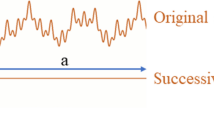Abstract
Accurate recognition of the type of ground motion is a basic task in the field of seismic engineering. In this paper, the key technologies of detection and recognition of underground seismic signal are studied. The target recognition algorithm is designed to realize the target recognition through denoising the collected target signal and extracting the characteristic quantity. Considering that ground motion signals generated by moving targets on the ground are susceptible to environmental noise, this paper introduces the working principle of wavelet packet denoising and its support vector machine classification model. Wavelet packet was used to transform the signal to denoise first, then zero-crossing rate analysis of the denoised signal was carried out after wavelet packet denoising and extracts the parameters, and the energy of cross-correlation criteria was selected finally. Quantitative indices are combined to construct multi-feature vectors, which are used as input of multi-class support vector machine for training and prediction. In this model, the optimal parameters of support vector machine model are found by genetic algorithm parameter optimization. The experimental results show that the improved model can recognize and classify the ground motion signals caused by people and vehicles correctly and can improve the performance of the classifier.







Similar content being viewed by others
References
Meier MA, Ross ZE, Ramachandran A, Balakrishna A, Nair S, Kundzicz P, Yue Y (2019) Reliable real-time seismic signal/noise discrimination with machine learning. J Geophys Res Solid Earth 124(1):788–800
Douglas J, Edwards B (2016) Recent and future developments in earthquake ground motion estimation. Earth Sci Rev 160:203–219
Liu X, Li Y, Wang Q (2018) Multi-view hierarchical bidirectional recurrent neural network for depth video sequence based action recognition. Int J Pattern Recognit Artif Intell 32(10):1850033
Lin GW, Hung C, Syu HS (2019) Evaluation of an enhanced FS method for finding the initiation time of earthquake-induced landslides. Bull Eng Geol Env 78(1):497–506
Zhou F, Gan J, Lv H, Cui L (2018) Application of wavelet analysis in underground embedded distributed optical fiber vibration monitoring system. In IOP conference series: earth and environmental science, vol 189, no 3, p 032025, IOP Publishing
Thanasopoulos I, Avaritsiotis J (2011) Wavelet analysis of short range seismic signals for accurate time of arrival estimation in dispersive environments. IET Sci Meas Technol 5(4):125–133
Zhang Y, Chen J, Sun C (2017) Damage-based strength reduction factor for nonlinear structures subjected to sequence-type ground motions. Soil Dyn Earthq Eng 92:298–311
Wang G, Wang Y, Lu W, Yan P, Zhou W, Chen M (2017) Damage demand assessment of mainshock-damaged concrete gravity dams subjected to aftershocks. Soil Dyn Earthq Eng 98:141–154
Zhu L, Liu E, McClellan JH (2017) Joint seismic data denoising and interpolation with double-sparsity dictionary learning. J Geophys Eng 14(4):802–810
Mousavi SM, Langston CA (2016) Hybrid seismic denoising using higher-order statistics and improved wavelet block thresholding. Bull Seismol Soc Am 106(4):1380–1393
Mousavi SM, Langston CA (2017) Automatic noise-removal/signal-removal based on general cross-validation thresholding in synchrosqueezed domain and its application on earthquake data. Geophysics 82(4):V211–V227
Zhang J, Jiang Q, Ma B, Zhao Y, Zhu L (2017) Signal de-noising method for vibration signal of flood discharge structure based on combined wavelet and EMD. J Vib Control 23(15):2401–2417
Maggi A, Ferrazzini V, Hibert C, Beauducel F, Boissier P, Amemoutou A (2017) Implementation of a multistation approach for automated event classification at Piton de la Fournaise volcano. Seismol Res Lett 88(3):878–891
Islam MS, Chong U (2015) Improvement in moving target detection based on Hough transform and wavelet. IETE Tech Rev 32(1):46–51
Nabian MA, Meidani H (2018) Deep learning for accelerated seismic reliability analysis of transportation networks. Comput Aid Civil Infrastruct Eng 33(6):443–458
Giudicepietro F, Esposito AM, Ricciolino P (2017) Fast discrimination of local earthquakes using a neural approach. Seismol Res Lett 88(4):1089–1096
Khandelwal M, Kankar PK, Harsha SP (2010) Evaluation and prediction of blast induced ground vibration using support vector machine. Min Sci Technol China 20(1):64–70
Mazzotti A, Bienati N, Stucchi E, Tognarelli A, Aleardi M, Sajeva A (2016) Two-grid genetic algorithm full-waveform inversion. Lead Edge 35(12):1068–1075
Asgari S, Stafsudd JZ, Hudson RE, Yao K, Taciroglu E (2015) Moving source localization using seismic signal processing. J Sound Vib 335:384–396
Wu Q, Wang L, Zhu Z (2017) Research of pre-stack AVO elastic parameter inversion problem based on hybrid genetic algorithm. Cluster Comput 20(4):3173–3183
Ghaffarzadeh H (2016) A classification method for pulse-like ground motions based on S-transform. Nat Hazards 84(1):335–350
Thomas S, Pillai GN, Pal K, Jagtap P (2016) Prediction of ground motion parameters using randomized ANFIS (RANFIS). Appl Soft Comput 100(40):624–634
McBrearty IW, Delorey AA, Johnson PA (2019) Pairwise association of seismic arrivals with convolutional neural networks. Seismol Res Lett 90(2A):503–509
Saad OM, Inoue K, Shalaby A, Samy L, Sayed MS (2018) Automatic arrival time detection for earthquakes based on stacked denoising autoencoder. IEEE Geosci Remote Sens Lett 15(11):1687–1691
Jia Y, Ma J (2017) What can machine learning do for seismic data processing? An interpolation application. Geophysics 82(3):V163–V177
Kirbas I, Peker M (2017) Signal detection based on empirical mode decomposition and Teager–Kaiser energy operator and its application to P and S wave arrival time detection in seismic signal analysis. Neural Comput Appl 28:3035. https://doi.org/10.1007/s00521-016-2333-5
Xiao F (2019) Multi-Sensor data fusion based on the belief divergence measure of evidences and the belief entropy. Inform Fusion 46:23–32
Acknowledgements
This work was supported by Jilin Province Science and Technology Development Plan Project (Grant No. 20180201036GX).
Author information
Authors and Affiliations
Corresponding author
Additional information
Publisher's Note
Springer Nature remains neutral with regard to jurisdictional claims in published maps and institutional affiliations.
Rights and permissions
About this article
Cite this article
Zhong, Z., Li, H. Recognition and prediction of ground vibration signal based on machine learning algorithm. Neural Comput & Applic 32, 1937–1947 (2020). https://doi.org/10.1007/s00521-019-04496-z
Received:
Accepted:
Published:
Issue Date:
DOI: https://doi.org/10.1007/s00521-019-04496-z




